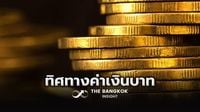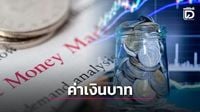The Thai financial markets are bracing for a pivotal week as key economic data, central bank decisions, and global policy signals converge to shape the outlook for the baht, equities, and investor sentiment. According to KBank Research Center, the upcoming days will see heightened attention on Thailand’s second-quarter GDP figures and July export numbers, as well as the closely watched remarks from the US Federal Reserve Chair at the annual Jackson Hole symposium. These events are expected to influence the movement of the Thai baht, which is projected to fluctuate within the range of 32.10 to 32.80 baht per US dollar.
Last week, the baht experienced a notable swing, touching its strongest level in three weeks at 32.24 baht per dollar before weakening again toward the end of the week. This volatility mirrored broader trends across Asian currencies, with the dollar initially under pressure due to speculation that the Federal Reserve might lower interest rates at its September FOMC meeting. However, the greenback regained ground after US producer price index data came in stronger than anticipated, as reported by Thai News Agency.
The Bank of Thailand (BoT) has been actively monitoring these global developments. On August 17, 2025, the BoT fixed the exchange rate for the week at 32.10-32.80 baht per US dollar, reflecting both domestic and international pressures. The Monetary Policy Committee (MPC) of the BoT, in a unanimous decision during its midweek meeting, opted to cut the policy interest rate by 0.25%, bringing it down to 1.50%. This move was designed to support economic growth amid persistent global uncertainties and was widely anticipated by market participants.
"The baht has managed to maintain its positive momentum following the MPC’s unanimous decision to reduce the policy rate by 0.25% to 1.50% midweek," KBank Research Center summarized in its weekly currency report. However, the baht’s gains were short-lived, as it softened again late in the week, aligning with the general trend among regional currencies. The US dollar’s rebound was buoyed by the higher-than-expected US producer price index, a key inflation indicator that often influences Federal Reserve policy decisions.
Looking ahead to the week of August 18-22, KBank expects the baht to oscillate within the 32.10-32.80 range against the dollar. The research center highlights several crucial factors to watch: Thailand’s Q2 GDP release, July export data, and the much-anticipated speech by the Federal Reserve Chair at Jackson Hole. The direction of foreign fund flows and global gold prices will also be closely scrutinized, as they tend to impact currency and equity markets alike.
On the equities front, the Thai stock market reached its highest point in six months last week, peaking at 1,283.55 points. This surge was fueled by optimism over potential rate cuts by the US Federal Reserve in September, as well as the BoT’s own rate reduction. Nevertheless, profit-taking by investors led to a pullback later in the week. For the upcoming week, KBank Securities projects support for the SET Index at 1,240 and 1,215 points, with resistance levels at 1,280 and 1,300 points. The interplay between domestic economic data and global policy cues is expected to dictate the market’s direction.
Gold prices, another barometer of investor sentiment, have also seen fluctuations. Over the past week, gold traded between 1,240 and 1,215 baht per baht-weight, with buying prices at 1,280 and selling prices at 1,300 baht per baht-weight. These movements reflect both local currency shifts and the broader global appetite for safe-haven assets.
The BoT is not operating in isolation. Its MPC is scheduled to meet again on August 29-30, 2025, to review and potentially adjust monetary policy in light of evolving economic conditions. This meeting follows the US Federal Reserve’s own rate hike on August 16, which saw the Fed raise its benchmark interest rate by 0.25 percentage points to 1.50%. The BoT is also keeping a close eye on policy signals from the Jackson Hole Economic Symposium, a key annual gathering where central bankers often signal shifts in strategy.
According to Thai News Agency, the BoT’s focus extends beyond the US, as it monitors economic indicators from other major economies. These include China’s loan prime rate announcement, July inflation figures from the UK and Eurozone, and preliminary August PMI data from the US, UK, and Eurozone. Such global developments can have ripple effects on Thailand’s financial markets, influencing everything from currency values to capital flows.
Market participants are also watching the release of the US Federal Reserve’s meeting minutes from July 29-30, which could provide further insight into the Fed’s policy trajectory. Other US economic data on the radar include housing starts, existing home sales for July, and weekly jobless claims. These indicators are expected to feed into broader expectations about the pace and timing of future interest rate moves, both in the US and Thailand.
For Thai exporters and importers, the recent currency fluctuations present both challenges and opportunities. A stronger baht can make Thai goods more expensive overseas, potentially weighing on exports, while a weaker baht can boost competitiveness but raise the cost of imports. The upcoming release of July export data will be especially important for assessing the health of this critical sector.
Meanwhile, the broader economic outlook remains clouded by uncertainty. While the BoT’s rate cut is expected to provide some support for domestic demand, external risks—including ongoing trade tensions, global inflationary pressures, and shifting investor sentiment—continue to loom large. The central bank’s cautious approach underscores the delicate balancing act facing policymakers as they seek to foster growth while maintaining financial stability.
In the words of KBank Research Center, "Factors to watch include Thailand’s Q2 GDP, July export figures, the Federal Reserve Chair’s speech at the annual Jackson Hole meeting, foreign fund flows, and global gold prices." These elements, taken together, will likely set the tone for Thai markets in the days ahead.
As investors, business owners, and policymakers alike await the next round of data and policy signals, the message from recent weeks is clear: vigilance and adaptability are essential in navigating an environment shaped by both local and global forces. The coming week promises more than its share of twists and turns—and all eyes are on the numbers, the policymakers, and the markets as they unfold.


